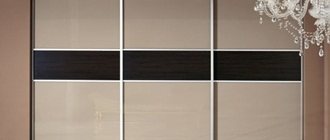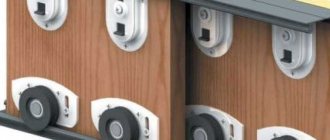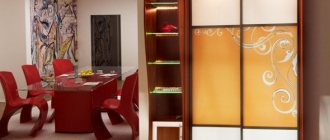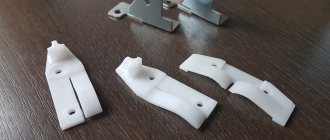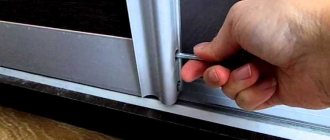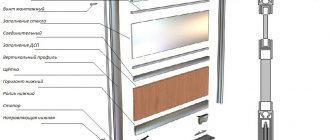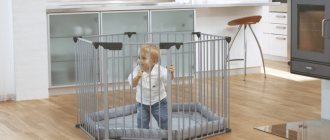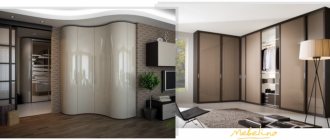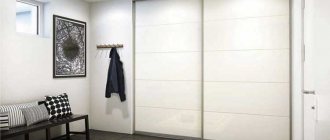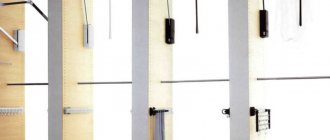104400
When assembling a sliding wardrobe yourself, it is important to know what each part that comes with the product is intended for. In order for the fittings for sliding wardrobes to be selected correctly, it is worth understanding the purpose of each part, as well as studying the filling elements of the products.
Purpose
Fittings - elements for connecting parts, lifting mechanisms, devices for expanding the functionality of furniture. This includes hinges, handles, holders, closers.
The accessories are intended for:
- body assemblies;
- installation of sliding doors;
- efficient operation of boxes;
- cabinet filling;
- fixing door leaves, protecting against swinging open or spontaneous closing.
For example, when assembling a cabinet, you can make changes to the filling and diversify the standard set with additional fittings, if space has been provided in advance for these purposes.
List of components
The standard set of furniture fittings for cabinets with sliding doors includes the parts presented in the table:
| Guide profile - fixed in the upper and lower parts of the body, firmly holds the doors in a vertical position and allows them to slide to the sides. |
| A door profile is a frame that frames the doors around the perimeter. |
| Rollers - installed on the door, facilitate easy opening and closing. |
| Stoppers—attached on both sides of the profile, slow down the movement of the leaf as it approaches the walls, and fix the position of the doors. |
| The seal is a soft tape that is glued to the side walls of the doors, dampens noise and vibration, prevents dust from entering the cabinet and protects the doors from knocking on the body. |
| A sliding system is a type of mechanism for moving doors. |
| Handles are mortise, the fastening of which occurs by milling the facade. They are made in round, oval or rectangular shapes. To save money or make it impossible to insert, the role of handles is often played by the door profile. |
Varieties
The main elements of a sliding wardrobe: body and facade. To connect them together and increase the functionality of the structure, a variety of fittings are required. It is selected taking into account the dimensions and structural features of this furniture.
The standard set of additional elements for a sliding wardrobe includes:
- profiles - used to frame the facade;
- guides - doors move along them when opened;
- rollers - these parts are used to move along the guides;
- stoppers - fix the position of the door leaves;
- seals - protect the body where the door is attached;
- sliding systems - mechanisms for moving the sashes;
- filling elements - increase the convenience of storing things.
Styles and colors of beautiful sliding wardrobes, popular designs
Having studied in detail the structure and functions of each type of fittings for sliding wardrobes, you can safely begin assembly or repair.
Guides
Profiles
Sliding system
Rollers
Stoppers
Sealant
Profiles
All kits for assembling sliding wardrobes are equipped with profiles: vertical and horizontal. The latter are needed for fastening the facade; they are called guides. The vertical ones serve as handles for opening.
Profiles are made from the following materials:
- Aluminum. It is characterized by high strength, lightness and durability. The aesthetics of an aluminum profile is improved by anodizing or gluing with PVC film. The result is a wide range of colors and textures.
- Steel. As a material for making fittings for sliding wardrobes, it is gradually becoming a thing of the past. The assortment is limited to a few solid colors or imitation wood on PVC film. Steel profiles attract low cost.
Plastic elements are practically not used as accessories for sliding wardrobes, since they are not strong enough for such structures.
Aluminum
Steel
Guides
The sliding doors of a compartment-type wardrobe are opened by moving the rollers built into the door leaf along the guide profiles. Profiles are attached at the top and bottom, sometimes only one option is used, installing stabilizers on the opposite side. If the piece of furniture does not have a body, the upper rail is attached to the ceiling, the lower one to the floor.
Based on the number of door leaves, select the appropriate type of guide profile:
- single-lane;
- two-way;
- three-way.
The guide profile plays an important role in the operation of the sliding facade system, so you cannot skimp on it. Poor quality of the element will cause the doors to jam when opening or the roller mechanism to pop out.
Single lane
Two-way
Three-lane
Rollers
In a sliding system, rollers play an important role. They provide movement in the grooves of the upper and lower guide profile. High quality parts glide over the surface smoothly and easily, and when equipped with bearings, they are absolutely silent.
They produce two types of rollers for wardrobes:
- symmetrical - used only along with a symmetrical vertical profile (closed handle);
- asymmetrical - applicable exclusively in combination with an asymmetrical vertical profile (open handle).
Symmetrical rollers ensure more coordinated operation of the sliding mechanism and eliminate door distortion.
Stoppers
For convenient operation of furniture with sliding doors, stoppers are used that fix their position. There is an opinion that it is not necessary to use them, but if there are more than two doors in the wardrobe, you cannot do without such elements. They are made of steel and have a spring design.
Types of sliding doors for wardrobes, standard dimensions
The number of stops must be equal to the number of cabinet doors. They are installed in the lower guide rail. By running over it when opening, the rollers fall into the gap between the plates, which leads to the fixation of the blade. It only takes a little effort to make the door move again.
Seals
The seal softens the impact of doors on the side walls when opening, making the process silent. Another function of this type of fittings is to close the gaps through which foreign odors and dust can seep into the cabinet. Door seals vary in material and structure.
For wardrobes, two types of elements are most often used:
- Brush (schlegel) - adhesive tape with bristles of artificial or natural origin. Glued to the profile recess.
- Silicone - varies in cross-sectional size. Attaches to glass and mirror door inserts of wardrobes.
Seals for wardrobe doors not only cope with noise, the penetration of odors and dust into the structure, but also increase the service life of the furniture.
Silicone
Brush
Sliding systems
Components for sliding wardrobes included in sliding mechanisms do not have to be ordered separately. The consumer is offered ready-made systems with all the necessary elements. They come in two main varieties:
- support - the entire load falls on the lower guide;
- suspended - the rollers are located only on the upper part of the canvas.
How to fit a classic-style wardrobe into the interior, tips
Support sliding systems are becoming more popular. They are cheaper and provide ease of installation. The smooth operation of such a sliding system is disrupted when debris accumulates in the bottom guide.
Support
Hanging
Filling elements
Proper arrangement of the interior space of the wardrobe will allow you to conveniently arrange clothes and other things. This feature of a new piece of furniture should be considered in advance. It is important to determine the volume and comfortable way to store each type of item. After this, draw up an approximate filling diagram.
The main elements are:
- shelves;
- boxes;
- baskets;
- rods;
- pantographs.
Pantographs ideally solve the problem of placing clothes at the top of the closet.
Baskets
Pantograph
Shelves
Barbell
Boxes
Pull-out fittings
The cabinet is filled with pull-out elements that are mounted on the following types of guides:
| Roller ones are the most popular on the cabinet furniture market. Allows loads up to 25 kg. They come with a door closer included. | |
| Ball - movement in them is carried out due to balls in the profile. The advantage is easy opening of the drawers and a variety of sizes. | |
| Metaboxes are a system with roller guides and drawer sides made of steel or plastic. Can be extended fully or partially. They come in different sizes and differ in filling elements. | |
| Tandems are guides that are hidden inside the drawer. When using such a system, the entire cabinet space is used with a gap of no more than 4 mm. The advantages include noiselessness and a variety of components. There is only one drawback - high cost. |
The filling depends on the functions of the cabinet and your budget.
Types of sliding mechanisms for sliding wardrobes by material of manufacture
Sliding mechanisms for sliding wardrobes can be made of steel or aluminum. The latter is considered more durable and wear-resistant. In addition, aluminum systems are lighter and do not weigh down the compartment doors.
Steel systems are more affordable in cost. If we consider cheap sliding wardrobes, then the doors can cause a lot of inconvenience during operation, namely, falling off the guides and moving along them with considerable noise. To do this, manufacturers use various mechanisms in sliding systems that soften sliding and minimize noise from the movement of wardrobe doors.
Sliding mechanisms made of aluminum are more advanced. The sliding system of such a cabinet is made of a high-strength profile framing the compartment door. The advantage is that when using such a profile system, the lower aluminum guide completely hides the roller mechanism. This allows you to use glass and mirrors separately as wardrobe doors. Aluminum mechanisms are more expensive than steel systems, but the average service life of aluminum profiles is about 20 years, compared to steel ones, which have a service life of approximately 5 years.
Filling elements
For dressing rooms, fittings are produced that allow you to neatly place clothes, shoes and other items. The convenience of the closet depends on it. Let's consider the main details of such accessories:
| Horizontal rod - a metal pipe designed for hangers, which is attached between the walls of the cabinet. | |
| Pull-out hangers are installed across the cabinet. They look like barbells and can be stationary or retractable. | |
| A retractable trouser holder for a wardrobe is attached to its rear or side walls and comes in several configurations. A model in the form of pins is considered convenient. | |
| Pantograph. Installed in large wardrobes up to the ceiling without mezzanines, when you need to place things in two rows. At the lower level, clothes are hung on static rods. On the top one there are hangers hanging on a pantograph. This is convenient for people of any height. | |
| Pull-out mesh baskets. A modern version of drawers that provides ventilation for things. | |
| Shoe shelves are similar to conventional drawers, but differ in partitions for rational placement of shoes. | |
| Belt holder - equipped with hooks for hanging by the buckle. | |
| The tie holder is a strip with small plastic hooks. | |
| Iron holder - wire retainer can withstand the maximum possible heating temperature of the soleplate of 205°C. Fastened with self-tapping screws in a separate compartment of the cabinet. | |
| The vacuum cleaner hose holder is also made of wire and allows for convenient hanging storage. |
When choosing what to fill your closet, think in advance about what will be stored in it and in what quantity.
If desired, locks can be installed on the cabinet doors to hide the contents from children. For example, the Lubby company produces latches and locks that limit the opening of drawers.
Types of hanging systems for sliding wardrobe doors
Due to its versatility, this design is used for doors that are installed not only in residential premises, but also in premises for other purposes - office, medical, public, etc.
- Roller suspension system. The rollers move inside the guide, allowing the doors to open/close smoothly and accurately. There are two varieties - with lower and upper mounting of rollers.
- Frame. The material for this system is a steel or aluminum profile for sliding doors. The latter is more expensive, but has better abrasion resistance.
- Frameless. It has a minimal cost, but its service life is much shorter. The main disadvantage is deformation when humidity increases or temperature changes.
- Radial. Used for sliding doors of non-standard shape.
Selection rules
When purchasing fittings for a wardrobe, look at the quality of workmanship - replacing it in the future will not be easy. The service life of moving elements, the load on shelves, and ease of use depend on the quality of components. The rollers must withstand repeated door openings, and the sliding mechanism must operate smoothly and effortlessly.
When purchasing components, take into account the manufacturer’s reputation and reviews of models; do not skimp on parts. Corners, hooks, door handles, profiles for facades, in addition to their main function, also perform a decorative function.
Expert opinion
Bashir Rabadanov
Technologist at the furniture company Woodband
Buy all parts from one manufacturer. This will protect against possible inconsistencies between the elements of the fittings, and therefore prevent inconvenience during operation.
The table shows manufacturers of reliable accessories whose products are on the Russian market. The rating is based on customer reviews.
| Manufacturer | Description | Made-Box rating |
| TOTAL | A company offering a huge selection of parts - hinges, boxes, handles, hangers. | 2 |
| ARISTO | A leading supplier of components with a network of stores across Russia. | 5 |
| COMMANDER | It produces fittings in two directions - luxury and standard. Steel profiles are used in budget cabinet models. | 3 |
| LUCIDO | Turkish manufacturer of sliding wardrobe mechanisms | 1 |
| HETTICH | A German company with a subsidiary in Russia. Operating for over 100 years. Hettich fittings are distinguished by their durability, consistently high quality and wide range. | 5 |
| BLUM | An Austrian company produces retractable systems and lifting mechanisms. | 2 |
| STANLEY | American manufacturer of furniture and accessories. Stanley specializes in door rollers; the company’s popularity was brought by its “anti-jump” technology, which ensures doors move without distortion. | 4 |
Tips for choosing
You need to select components for sliding wardrobes based on the quality of the parts. The rigidity of metal products, as well as the smoothness and softness of the roller systems, determine the durability and ease of use of a piece of furniture. Door hardware must withstand daily loads, so you should not purchase cheap models. It is important that the internal content is properly planned. It is necessary to pay attention to the material of manufacture of all components. You should also consider the following recommendations:
- the size of the guides must correspond to the dimensions of the cabinet and the length of the doors;
- the rollers must ensure smooth and silent running;
- closers need to be chosen that will easily withstand the weight of the door leaf;
- sealants should not shrink or leave marks on the surface.
When choosing the main components, you need to pay attention not only to the quality of the material, but also to the reputation of the manufacturer. The design will last a long time if the components are selected in accordance with the dimensions of the product. You also need to know the rules for operating sliding wardrobes.
A sliding wardrobe is a universal piece of furniture in which you can store a huge number of things. It fits well into any interior and also helps to divide the space into zones. The correct choice of model will allow you to implement even the most complex project.
Types, sizes and designs of radius sliding wardrobes, placement tips
The size of the guides must correspond to the dimensions of the facade
It is better to choose silent rollers
Closers must be able to withstand the weight of the door leaf
It is important that the seal does not shrink
Brief conclusions
Finally, let's not forget about structural fittings. This includes hardware that is used to connect parts, canopies, install doors, body elements, guides and filling. Essentially these are screws and bolts; they must be made of high-quality metal and perform a simple fastening function.
Depending on the type, fittings can ensure the strength and integrity of the structure, expand the functionality of the furniture, and also serve as an original decorative element. It is better to immediately buy quality products from recommended brands.
